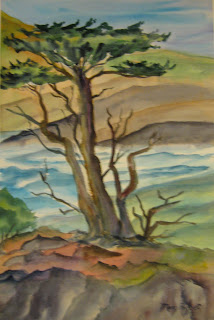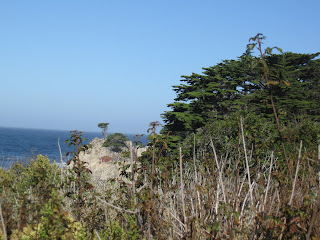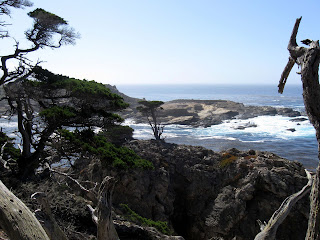
"Headland Cove"
Point Lobos State Reserve
14" x 21"
Watercolor

View near the end of Cypress Grove Trail with my Cypress tree on the cliffs

My view as I painted

Another view from where I painted
I just returned from my first "Carmel Paintout" with the Santa Clara Valley Watercolor Society. I had a fabulous time staying two nights at Asilomar, a state conference center originally desiged for the YWCA by Julia Morgan. I felt like I stepped back in time to experience the national park vacations that people took almost a century ago. It's the same feeling I've had when stepping into the Lodge at Yellowstone and the Awanee Hotel in Yosemite.
In the next few posts I will describe more about the experience. I am jumping in with Day 2 because that was the only full-day I had there. I arrived Thursday morning and left right after breakfast Saturday for another commitment. Each day of the paintout, artists are given a suggested location for painting. For Day 2 it was Point Lobos State Reserve, an amazing confluence of land and sea. Some people chose to remain at Asilomar to enjoy painting on the grounds. I love going out plein air, though I will admit it's a lot more work than studio painting and few keepers emerge.
After breakfast in the dining hall, I arrived at Point Lobos to see one other artist at one of the trailheads. We went our separate ways. Last Christmas, Bob and I spent some time in the park hiking the Cypress Grove Trail and I knew just what scene I wanted to capture. I became concerned that I might not find a place to set up because the trails are carefully wired off with signs not to leave the trail for ecoological reasons. Fortunately, there is a overlook on Headland Cove open to hikers, overlooking the cove, and Sea Lion Point. Below me was a wonderful old Cypress tree clinging to the rocky cliffs at the continent's edge. If you've been to the Monterey Bay area, you know that Monterey Cypress are very special trees that cannot be cultivated away from the cool, moist sea breeze -- they will succumb to a fungus disease. They require heat or fire to release seeds from their cones. They are the original reason that Point Lobos was acquired. This stand of Monterey Cypress of one of only two naturally growing stands in the world.
I found a perfect spot for my easel where I would not be in the way of many hikers stopping by that day. To one side there was an old downed tree trunk where I could sit facing the scene sideways. As you can see from picture 3, I had to look around a part of a dead tree, but that was easy. I had perfect weather. Often this area is foggy, but that day it was picture perfect blue skies, sun, and a shirtsleeve temperature. As I painted, I could hear the sea lions barking from the headlands. The name "Point Lobos" refers to sea lions and their barking. The earlier Spanish name was "Punta de los Lobos Marinos," "Point of the Sea Wolves." I kept thinking, life does not get much better than this!
My photos of the scene do not do the beauty justice; I thought to take them after I completed the painting; the light had changed and was less dramatic. The local color is used in my artwork. The shades of orange around the base of the tree are algae that get their color from carotene, and they do not harm the trees. I suggest the energy of the wind and and crashing sea with many energetic strokes of the brush. I mostly used a very large Isabey squirrel brush to capture the scene. I love this brush as it carries lots of paint and water and creates a lovely painterly surface. I took time out to eat my boxed lunch that the dining staff provided. I chatted with a few of the hikers, all very respectful about wanting a peek at the work.
Later I drove to yet another parking area to find two of my fellow artists at work and joined them, but I save the afternoon description for another day. That evening I enjoyed some socializing before dinner with women I met for the first time and we all went to dinner at 6. At 7:15, we convened in a livingroom for critique. Karen, our fearless leader, set the groundrules for a gentle critique, modeling how we might make helpful suggestions. For everyone, exposing their work to others stirs up the self-doubt, but I always learn so much from participating in critique, not only about my own work, but that of others -- what worked, what didn't --- that I can apply the next time I paint. This piece was well-received, with one suggestion, which I added before signing the painting. The tree looked very flat across the top, and I painted it that way. I needed to add a bit of variety to the edge.
 "Jeff and Beth, Down on the Farm"
"Jeff and Beth, Down on the Farm"
















































.jpg)


























































